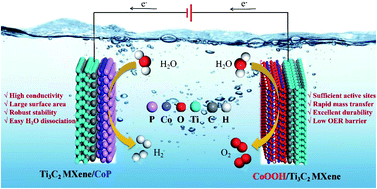A general approach to the synthesis of transition metal phosphide nanoarrays on MXene nanosheets for pH-universal hydrogen evolution and alkaline overall water splitting†
Abstract
Exploring highly efficient, stable, and non-noble-metal bifunctional electrocatalysts for overall water splitting is greatly desired but still remains an ongoing challenge. Transition metal phosphides (TMPs) have been utilized as promising bifunctional electrocatalysts for the hydrogen evolution reaction (HER) and oxygen evolution reaction (OER), but practical implementation is impeded by the low electronic conductivity and poor chemical stability of TMPs. Recently, a new class of 2D materials, MXenes, have attracted significant attention for diverse energy-related applications. Here, a general approach is reported to synthesize TMPs, including CoP, Ni2P, FeP, and Cu3P nanoarrays, on Ti3C2 MXene nanosheets through topotactic transformations from transition metal layered double hydroxide (LDH) precursors. The Ti3C2 MXene in the CoP/Ti3C2 MXene heterostructure acts as a highly conductive substrate which not only facilitates rapid electron transfer at the heterointerface, but also prevents the TMP nanoarrays from aggregation. Meanwhile, TMP nanoarrays prevent MXene nanosheets from restacking and contribute remarkable activity and long-term stability. Particularly, the strong interactions between CoP and the Ti3C2 MXene endow the CoP/Ti3C2 MXene heterostructure with exceptional catalytic activities and stability toward the HER at all pH values. Moreover, the CoP/Ti3C2 MXene also exhibited superior OER performance in alkaline electrolyte. Consequently, the CoP/Ti3C2 MXene even outperforms the commercial Pt/C‖IrO2 couple for overall water splitting under alkaline conditions. The experimental results reveal that the strong electronic coupling effect at the heterointerface can efficiently accelerate the HER/OER kinetics. This study opens up opportunities to rational design of advanced electrocatalysts for diverse applications by using the MXene family as the underlying support coupled with various active components.



 Please wait while we load your content...
Please wait while we load your content...